Film 10 Midterm Terms
1/73
There's no tags or description
Looks like no tags are added yet.
Name | Mastery | Learn | Test | Matching | Spaced |
|---|
No study sessions yet.
74 Terms
Zoetrope
George Horner, cylinder with moving images
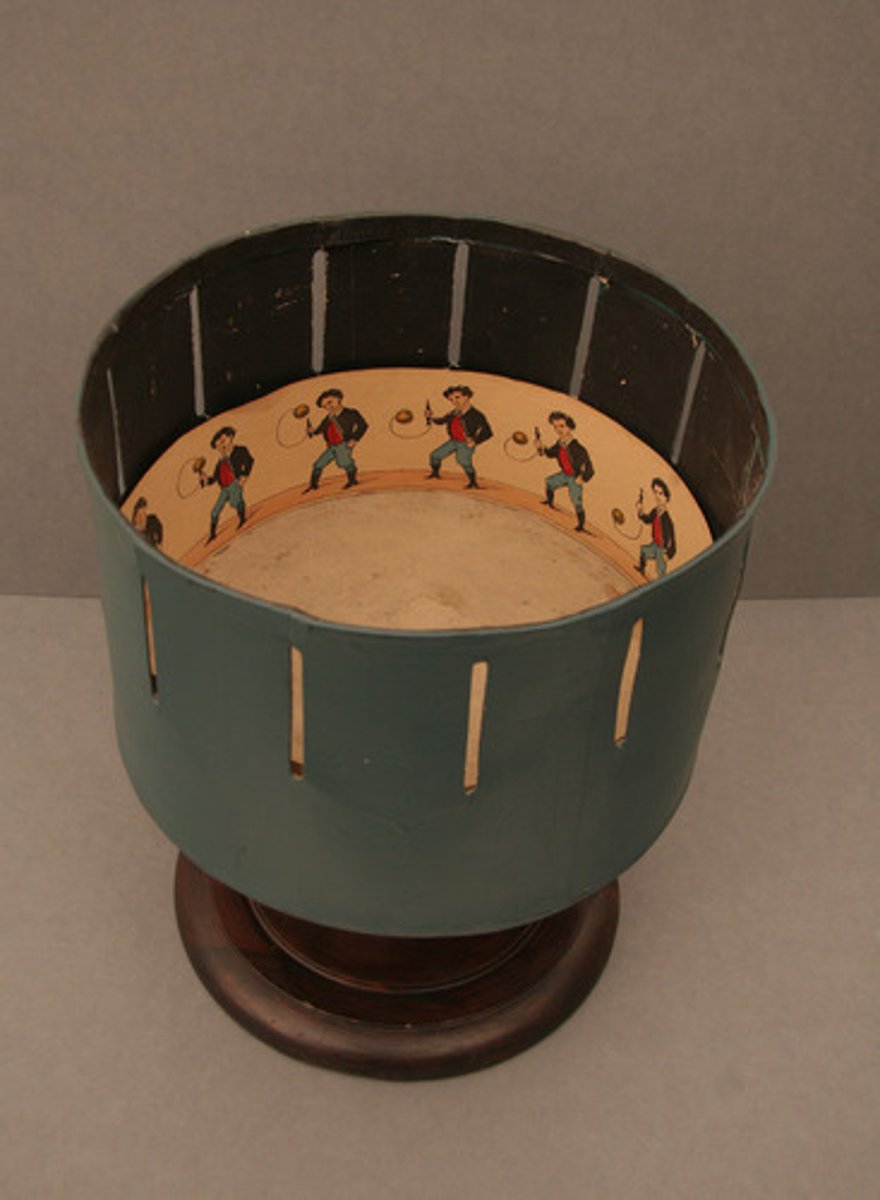
Thaumatrope
Dr. John Paris, twirling image

Phenakistoscope
Joseph Plateau, deceptive view
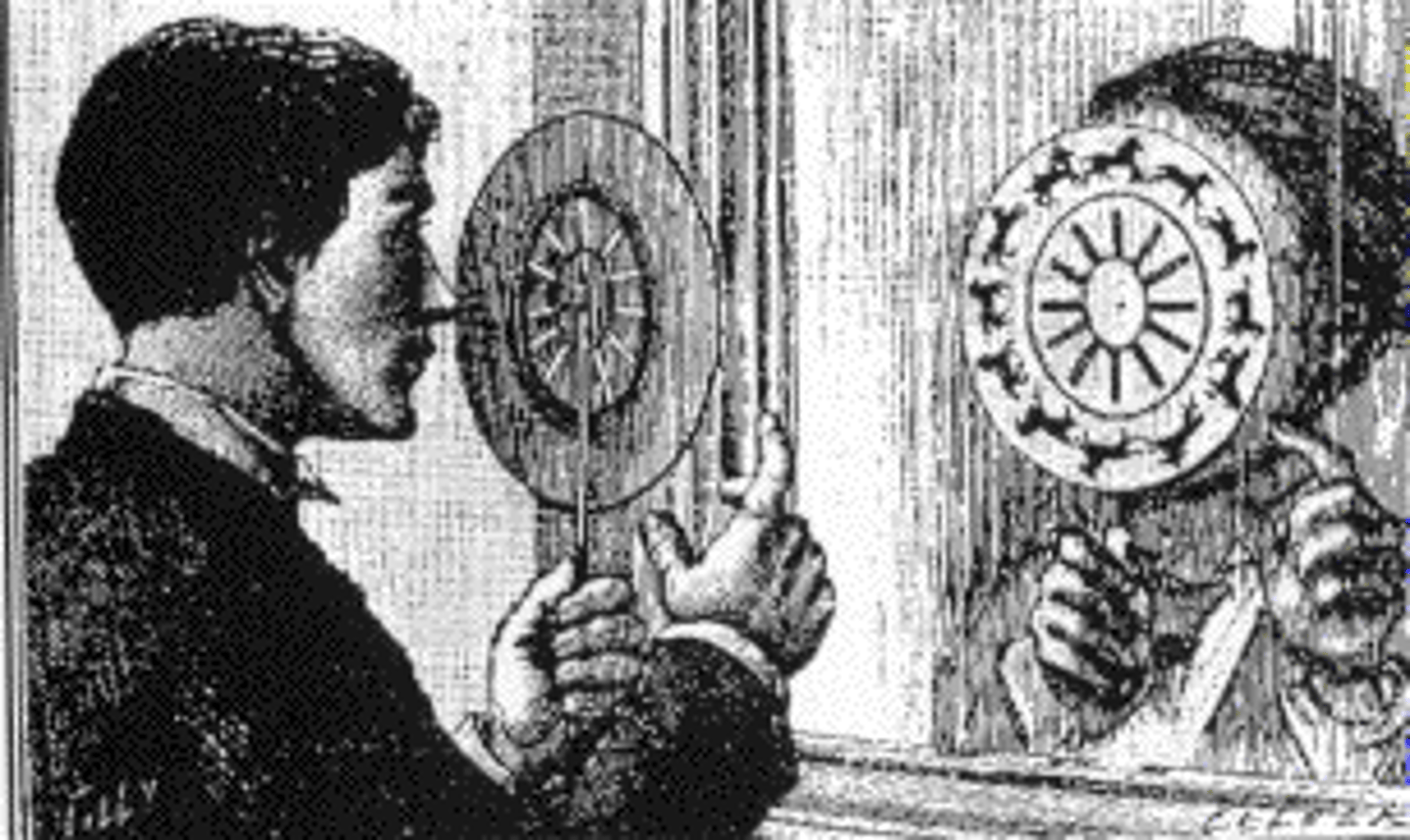
Stereoscope
Wheatstone (1832), binocular images, designed for science
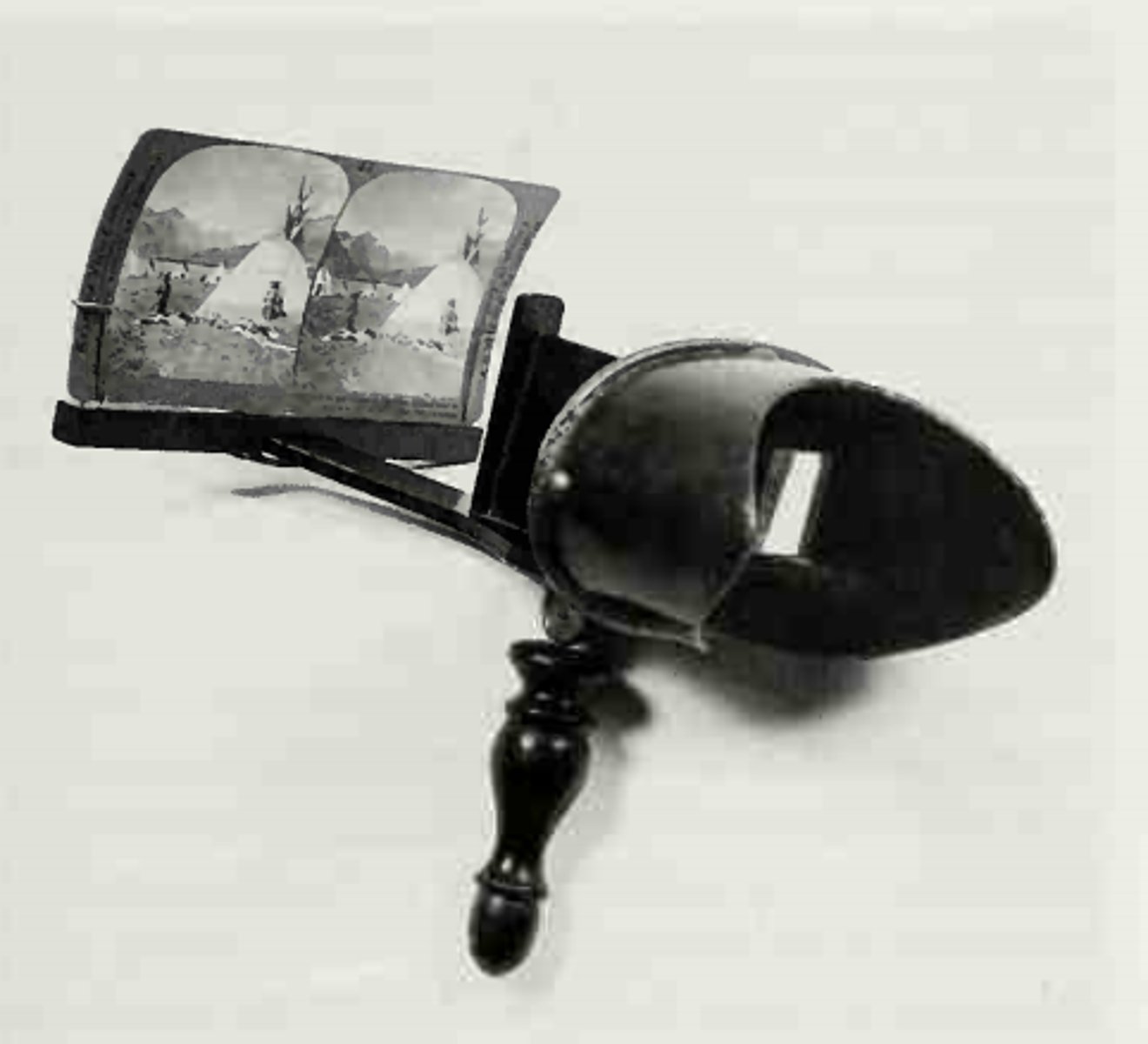
Persistence of vision
1824, Peter Mark Roget, the eye retains an image on the retina for a fraction of a second after the image has been removed from the field of vision. As a result, when a series of images are perceived in rapid succession, the eye will "fill in" any gap between
Magic lantern shows
1896, first projection device, could make the images shrink and get big, disappear or appear quickly, or have objects projected on space
Phantasmagoria
1799, Robertson's phantasmagoria in Paris, the first live horror show
Dissolve
a transition between two images or scenes in which the first image or scene gradually fades out as the second gradually fades in, with some overlap between the two
Kinetoscope
1892, W.K.L. Dickson and William Heise, Edison, parlors, shows tech
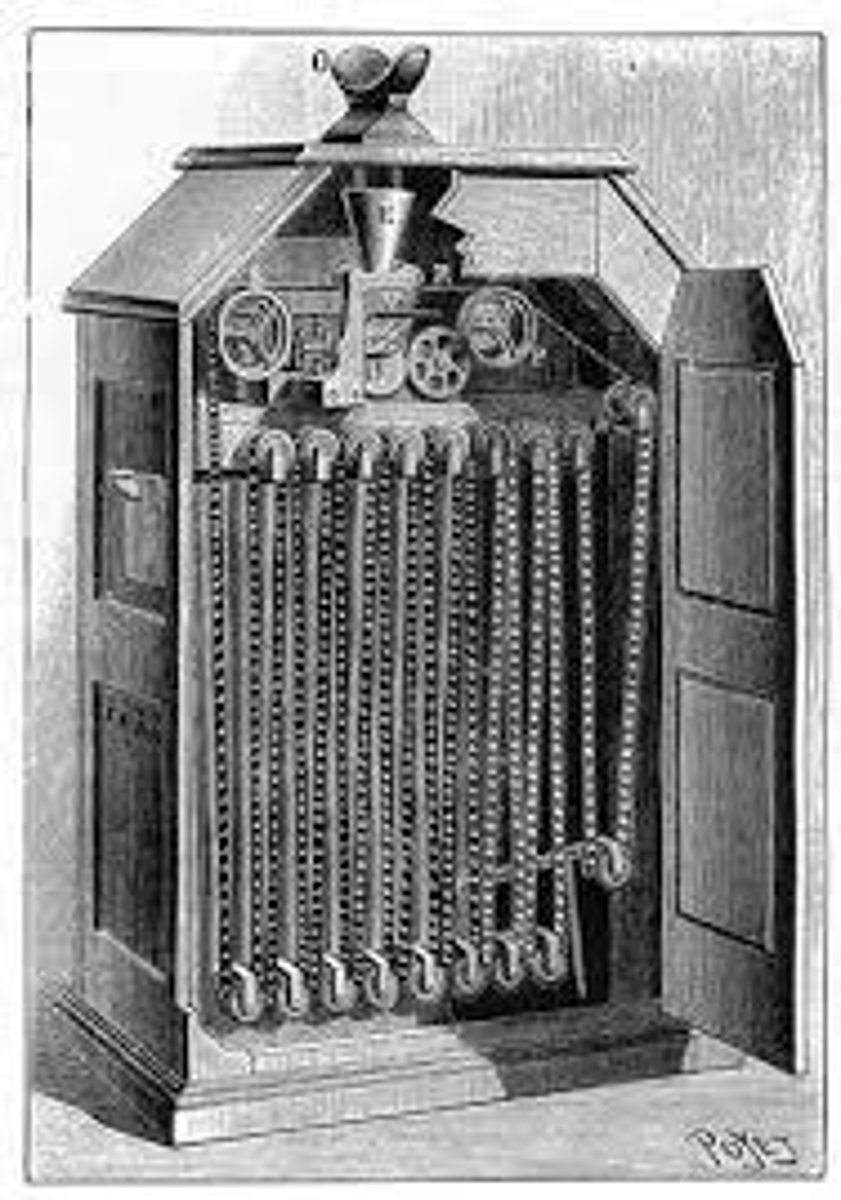
Cinématographe
Lumiere, debuted in the Salon Indian of the Grand Cafe in Paris, December 28, 1895, a camera and a projector
Vitascope
1896, Edison vitascope, moving pictures and projecting them in magic lantern fashion
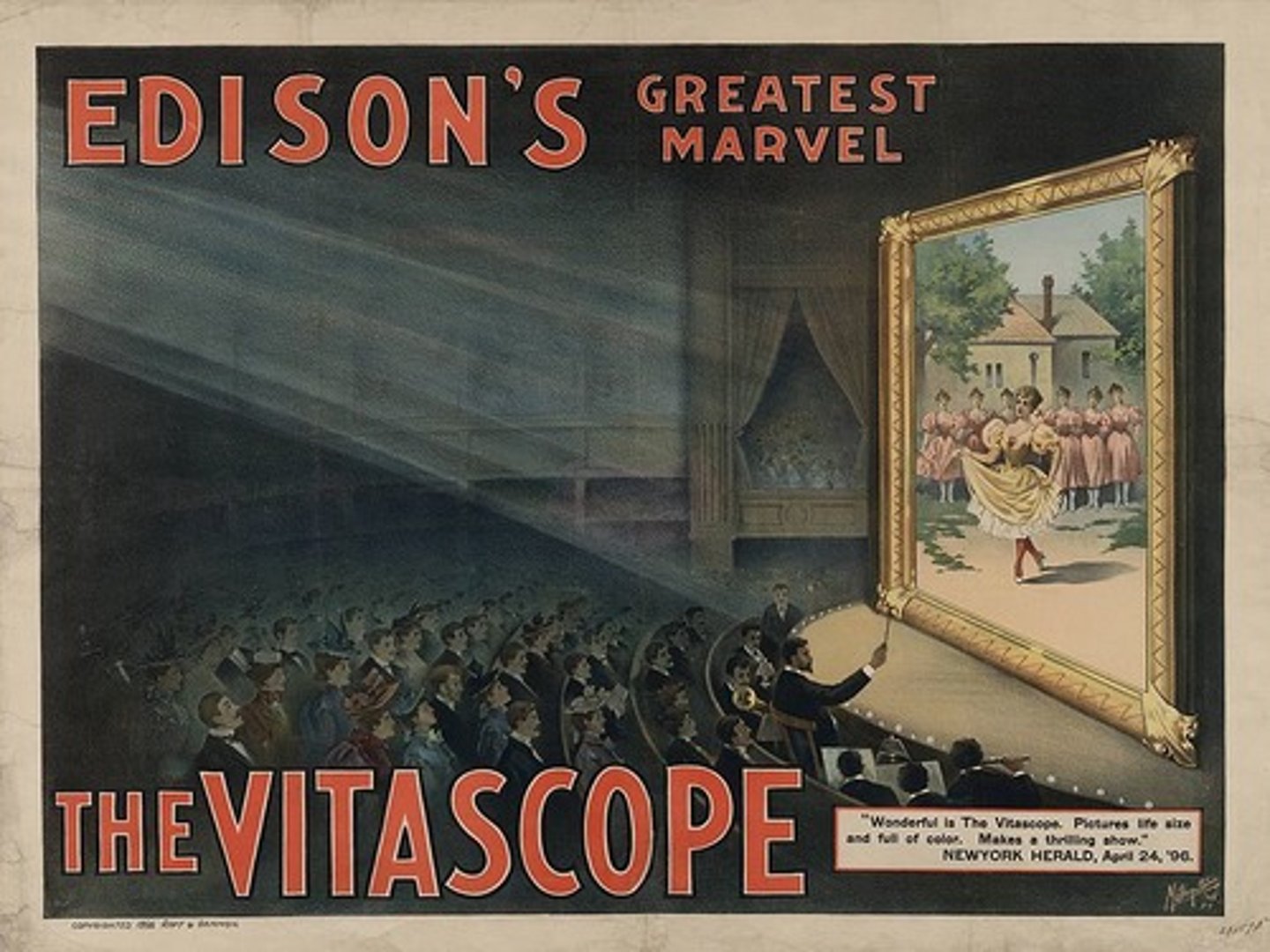
Thomas Edison
important inventor, then patenter, then studiohead
Latham loop
1894, Woodville Latham, came from a projector, causes slack, able to have films longer than 3 minutes since it wouldn't get caught/snap
Black Maria
1893, Edison's film studio, black box with natural light, first studio
Edison's first moving picture demonstrations
films like Corbett Fight, The Kiss, bringing world his camera in Black Maria
Overlapping editing
multiple shots showing the same action
Spectacle
the display of impressive or astonishing sights meant to have heightened impact on vision
Coney Island
peninsula on the southern end of Brooklyn, catered toward working and middle class, leave their propriety at the gates and lower their inhibitions, everyone on display, mixing of all groups
Vaudeville
paid a single price to see multiple attractions as many times as you want, originally just a theater, when?
Formal features typical of films made during the novelty period
1. Single shot of a performance
2. Minimal editing
3. Static/tableau shot
4. Looking into the camera/exhibitionism
5. No "resolution" or closure
Louis Lumière
bringing the camera outside and showing parts of the world that some people had never seen, diagonal space, actuality
Cinématograph at the Grand Café
Lumiere, debuted in the Salon Indian of the Grand Cafe in Paris, December 28, 1895, a camera and a projector
Exhibition strategies for debut of Arrival of a Train at Ciotât Station (Lumière 1895)
Shock is tied to suspense to increase impact of the film, creation of suspense based on delay of anticipated suspense
Actualities
genre of everyday life ie. street scenes, famous cities, architectural models, troops marching, topical or newsworthy relevance to audiences (Lumiere)
Contrast between Edison and Lumiere films
Lumiere was more about everyday life, actuality genre, going out in the world vs. Edison was more focused on the stage, bringing the world to them
Main Features of the Cinema of Attractions
1. Short films of non-narrative spectacle, 2. Spectacle prevails story, 3. Direct mode of address & exhibitionism, 4. Discontinuous temporality
Georges Méliès
pioneer of trick & magic films, ornate sets, fairy tales, Melies Kinetograph
Star Films
George Méliès' production company after he quit his live magic routine
Stop-motion animation
spectacle used in "The Teddy Bears" (1907), start and stop
Stop-motion substitution
a form of in-camera editing in which the camera is started and begins to film a scene until, at a precisely timed moment, the camera is stopped, a substitution or changed is made in the scene, and the camera is started again
Trick film
spectacle over narrative, trick is the point, discontinuous display of attraction, complex splicing/editing
Peephole film
the act of looking, discontinuous sequence, no real story or set sequence of events, vignette, looker punished at the end
Exhibitionism
self conscious display where the spectator is directly addressed by the film, performers look into the camera and acknowledge the audience
Chase film
extend dynamic action across space and time, diagonal, foreground/background, suspense, adding length
Continuity
the continuous flow of a film, where shot follows shot and scene follows scene in a coherent, transparent, and understandable manner
Role of the lecturer
provide some live narration to help the audience understand when and where, but meaning of film was curated by outside sources
Story films
1902, George Melies provoked this shift, arrived as actualities and non-narrative trick film lost appeal, story wasn't minimal framework for tricks, but integrated story and spectacle, furthered each other as equals, increased film lengths (more than 50 seconds), but doesn't rely on continuity like narrative
Edwin S. Porter
pioneer of film using recognizable stories, works in Edison studio, first elaborate American portrait film (Jack & the Beanstalk), attempts to make stories with shots (Train Robbery), but resists mass production, fired for not adapting to new era
John Harris & Harry Davis
Opened the first nickelodeon in 1905
The nickelodeon (impact on film industry)
first place dedicated entirely to moving pictures, huge demand for new films, standardized production, and associated moving pictures with illness and vice (filled with working class)
Christmas closings of 1908
major crisis when mayor of NY ordered closing of all Nickelodeons in NY, said they posed moral and physical problems, poor ventilation, inappropriate actions, appeal only to lowest and evil passions, demise of moving pictures (needed to regain respect by bringing middle class viewers), plus shift to California
Biograph Co.
fought against Edison on patents/copyrights until they both organized the MPPC, created monopoly to save film
D.W. Griffith as director
hired by Biograph, unprecedented narrative clarity, theater background, characters with clear motivations for their actions (clear evil or good) taken from stage melodrama, took greater control over production of his films, Suspense Melodrama structure
Motion Picture Patent Corporation (MPPC)
a monopoly or trust organized by the Biograph and Edison film production companies (1908) that sought to control all aspects of production, distribution, and exhibition in the United States and make film "respectable", MECA motto, rules to be followed by all member companies, but feature films caused its decline in 1913, officially dissolved in 1915
1. Standardized technology
2. Standardized length (one reel)
3. Controlled distribution
4. Formed a Board of Censorship
Board of Censorship
to regulate the content of films, which had to have both moral clarity and narrative clarity, staffed with industry professionals
Cross cutting
camera cuts between 2 or more related actions that occur simultaneously in different locations, separate lines of action eventually intersect
Self-sufficient narrative
audience didn't need prior knowledge of a historical event or novel to understand the story
Transitional era
from cinema of attractions (1908 Xmas closings) to classical narrative (1915/16/17), starting standardized production (ie studio, California, serials)
Suspense melodrama/four part structure
action-based drama, dynamic & action-oriented, satisfies audience and censorship/religious leaders with moral clarity
1. Begins with a stable situation enjoyed by protagonists identified as "good"
2. Disruption of the stable situation by an outside evil power or force
3. Disequilibrium prompts a counter-action undertaken to re-establish equilibrium
4. The story ends with a return to the stable situation from beginning
Proximity of camera
used to be far away, but clear facial expressions due to close camera, express good and evil (not far over the top performances), DW Griffith
US serial films
long narratives shown in episodes over months or even years, self-sufficient stories, inspired by suspense melodrama and dime novel, end on cliffhanger, loyal audience, curious of the tech, an awe in the power and efficiency of these technologies yet also anxieties for violent and technological breakdowns, DYNAMIC SPEED
Female audiences and the serial
"new woman", the liberation of leaving the domestic sphere and gaining independence AND the anxiety of navigating new technologies and public spaces
Serial queen
fast cult following, first international film stars, star system came from transitional era
Star system
1912, the exploitation of the on-screen career and off-screen life of specific performers to sell motion pictures by using publicity such as magazine articles, promotional stunts, and tie-ins
Studio system
large scale method of making films in the classical era
1. Multiple films made simultaneously on different lots
2. Each project headed by a director with detailed shooting script that laid out the entire film shot by shot
3. Studio head had the final say on editing and finished product
4. To save money, scenes were shot out of order
5. Production had a clear division of labor: each aspect was handled by a group of specialists called a department
6. Each studio specialized in the production of formulaic genres
Thomas Ince
Created Inceville, his studio known for westerns, he approved the shooting script ahead of time and made sure the directors followed very tight production schedules
Inceville
the first large-scale Hollywood studio, was established by Thomas Ince in 1913, organized production around a factory-mode that became known as the "studio system"
Classical narration
around 1915, standardized by 1917, ends in 1960 when the studio system falls apart
1. Follow the development and progress of a story through a protagonist where the qualities of characters are consistently presented to the spectator through acting style, costume, setting, dialogue, and action (clearly motivated)
2. Two goals: a conflict that must be resolved or a problem that must be solved, second is the formation of reunion of a romantic couple
3. Image is usually centered, with the important information at center & less important objects at outer edges
4. Continuity editing, being transparent through the careful matching of details in costume, setting, and camera placement
5. Spectatorship, spectators feel visually absorbed into the film, thanks to continuity, "voyeuristic": the spectator watches events unfold in secret, as if through a mobile keyhole
Continuity editing
editing is meant to be transparent or invisible so that the spectator can be absorbed into the world of the film, "transparency" is created by continuity editing and through the careful matching of details in costume, setting, and camera placement
Tie-ins
writings where the serial queens would be in adventurous situations, conflate the image of on and off-screen personalities, also used to sell products like dresses, also their home life, sometimes had extra background on the episode
Louis Feuillade
Director of Les Vampyres, his mise-en-scene is very ornate, he suggests no place is secure and nothing is as it appears which creates paranoia
French serials
hyper violent and paranoid in tone
Paranoia in Les Vampyres
no place is secure and nothing is as it appears which creates paranoia, free floating anxiety with no specific object, everything and everyone is to be feared through his use of space and presentation of character, France fighting with Germany (spies)
Mise en scène
placing on the stage, all visual elements of a shot, shot composition, lighting, movement, costuming, and set design
Orientalism
how the west defined itself through its fictional constructions of the East, from 1700s, asian countries as fictionalized figures on a stage, not the reality of the various cultures but the imaginative geography of the orient: divides the world into two (east vs. west) and also incompatible opposites, making a series of myths to Asian people with no evidence
Lasky lighting
renaissance lighting, associated with the Jesse Lasky company, it removes fill lights and backlighting to create chiaroscuro effects, in which small areas of the frame are brightly lit to contrast with dark areas and deep shadows that fill the rest of the frame (lowkey lighting), associated with The Cheat
Racial melodrama
subgenre that dramatizes a conflict between racially coded and morally polarized characters who are presented in highly visible schematic terms
Race pictures
a term of pride that identified films about black life that were made by black filmmakers for the black community, family, romance, religion
Uplift cinema
predominant social and political ideology concerning progress for Black people, emphasized individual initiative, mutual assistance, social respectability, interracial cooperation, and economic independence as components of a general strategy for promoting the advancement of Black people
Oscar Micheaux
His films criticized black and white american culture, causing fights with censors, The Conquest book to The Homesteader
Mutual vs. Ohio (1915)
films are commerce not speech and therefore are not protected by the First Amendment of the Constitution
Coney Island Parks
Steeplechase Park, Luna Park, and Dreamland
William K.L. Dickson and William Heise
Began by making short films in May 1893 in the physics department of the Brooklyn Institute, Edison
As MPPC lost monopoly over film production in US, the feature film emerged as a new popular form
TRUE